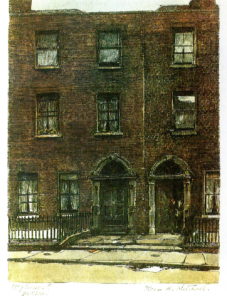
Maurice Earls writes: Six hundred copies of Vanishing Dublin by Flora Mitchell were published in 1966 by Allen Figgis. The book offers short descriptions of numerous streets and lanes in Dublin, each illustrated with one of the author’s watercolours. The book, which has never been reprinted, struck a chord with the public and copies, when they do become available as the libraries of the deceased surface in the city’s auction rooms, are quickly seized upon. The attraction is the watercolours in which Mitchell somehow captures the sadness of a beautiful and decayed city about to be transformed with the arrival of money and the wrecking ball. Below is the publisher’s introduction, taken from the dust jacket.
Many of the buildings shown in this enchanting record have disappeared from the face of our city. They belonged mainly to the eighteenth century and were built on clay, without effective damp-courses. Since the chief social importance was at that time attached to the front elevation, first-class bricklayers and masons were engaged for the facade only. After the Act of Union, these dwellings and town houses of the gentry changed hands and rapidly deteriorated into slum tenancies. Thus large areas of eighteenth and early nineteenth-century Dublin were already in poor condition when, in the summer of 1962 and winter of 1963, abnormal weather conditions led to the collapse of many houses. Entire squares and Georgian avenues were found to be past repair and demolition began.
Yet by the grace of the artist’s pencil and watercolour brush, the charm of our Vanishing City has been captured and kept. Flora Mitchell – like Malton, Brocas and others in bygone centuries – gives us here a priceless record, not indeed of Georgian Dublin in its pristine freshness, but of the richess and texture of the crumbling city of her time.
As a student in the Metropolitan School of Art, Mitchell fell in love with Dublin on the Liffey, shabby and beautiful. She had an eye for the splendid public buildings with the pale Irish sunlight on their floating domes of granite and verdigris, but above all she sought out the lesser-known courts, alleyways, bridges, byways and narrow streets, making drawings of them, transmuting the lines of them and the almost personal quality of their brick and stone. Later, living high up in a flat in Grafton Street, the wonderful rooftop views suggested to her that she might one day crystallise the essence of Dublin in line and colour. She set to work and three exhibitions of her pictures were so successful that she was encouraged to carry on and make a record of the local scene, although not then aware that much of it was soon to vanish forever.
The artist possibly owes her fresh eye for the city streets to the fact that she was born under wide skies on the cattle ranges of Western America. She married the late William Jameson, who was a great-grandson of the founder of John Jameson’s Distillery, and a well-known amateur rider and yachting helmsman, so that most of her life has been lived in or around Dublin. She has captured the spirit of the town and has never ceased recording it; by now her collection includes over 200 views, of which the 50 reproduced here form part.

Here is Mitchell’s account of York Street:
Here the substantial houses of well-to-do citizens of past days stand up to the invasion of families whose battle against poverty is bravely hidden behind lace curtains, and the happy games of the numberless children, well dressed and cared for, who play in the old street. If we could look in behind the often glassless fanlights of the handsome and varied doors, our sympathy would indeed be for those who have suffered much hardship and overcrowding here during the past century. And every day the crash of demolitions comes closer.
And here is her account of Stephen Street:
On the corner till recently could be heard the fish sellers calling their wares in the unmistakable accents of the Coombe: ‘some good fish here!’ being one of the noncommittal cries; and a dumbfounded passerby is said to have overheard a shrill request to a Mrs Kelly to ‘lift the baby up and let the lady see the fish!’ Be this as it may, even today the call of ‘three oranges or two more apples a shilling!’ assails the puzzled ear from the descendants of the ‘fishmongeresses’ of past times. Perambulators of ancient design are still used as receptacles for the fruit which has now taken the place of the fish of other days.
Illustrations: Flora Mitchell’s portrait of 7 Eccles Street in the 1960s. Reproduced in David Pierce’s James Joyce’s Ireland. Mitchell’s Aungier Street, Dublin (1966).
18/4/2019



